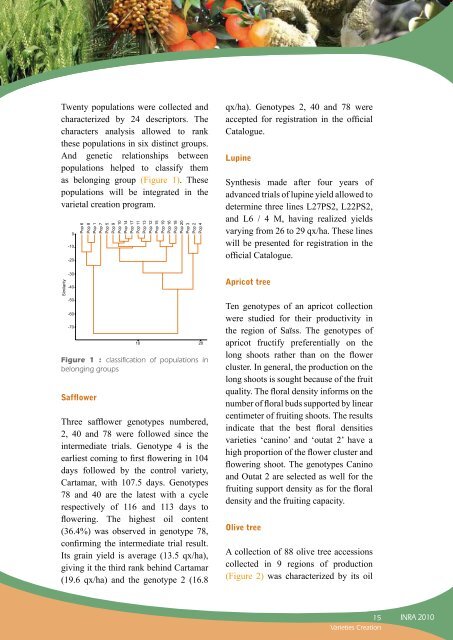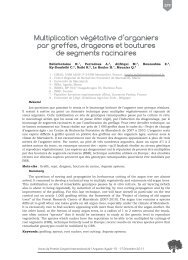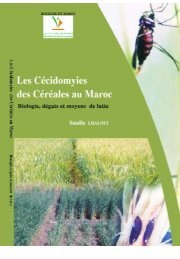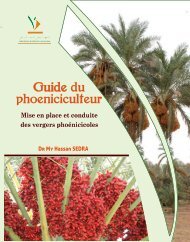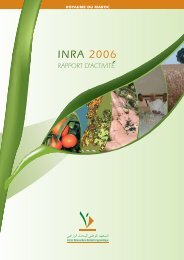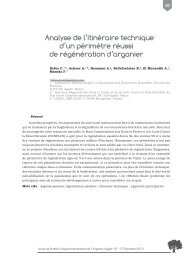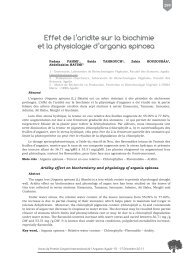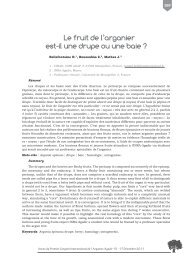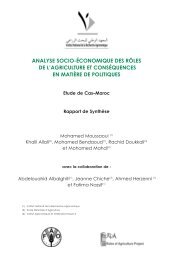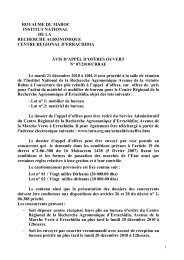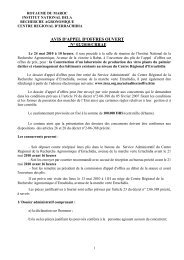varieties creation and conservation of plant genetic resources
varieties creation and conservation of plant genetic resources
varieties creation and conservation of plant genetic resources
Create successful ePaper yourself
Turn your PDF publications into a flip-book with our unique Google optimized e-Paper software.
Twenty populations were collected <strong>and</strong><br />
characterized by 24 descriptors. The<br />
characters analysis allowed to rank<br />
these populations in six distinct groups.<br />
And <strong>genetic</strong> relationships between<br />
populations helped to classify them<br />
as belonging group (Figure 1). These<br />
populations will be integrated in the<br />
varietal <strong>creation</strong> program.<br />
Similarity<br />
0<br />
-10<br />
-20<br />
-30<br />
-40<br />
-50<br />
-60<br />
-70<br />
Pop 6<br />
Pop 8<br />
Pop 1<br />
Pop 7<br />
Figure 1 : classification <strong>of</strong> populations in<br />
belonging groups<br />
Safflower<br />
Pop 5<br />
Pop 9<br />
Pop 10<br />
Pop 14<br />
Pop 17<br />
Pop 11<br />
Pop 13<br />
Pop 12<br />
Pop 15<br />
Pop 19<br />
Pop 16<br />
Pop 18<br />
Pop 20<br />
Pop 3<br />
Pop 2<br />
Pop 4<br />
10 20<br />
Three safflower genotypes numbered,<br />
2, 40 <strong>and</strong> 78 were followed since the<br />
intermediate trials. Genotype 4 is the<br />
earliest coming to first flowering in 104<br />
days followed by the control variety,<br />
Cartamar, with 107.5 days. Genotypes<br />
78 <strong>and</strong> 40 are the latest with a cycle<br />
respectively <strong>of</strong> 116 <strong>and</strong> 113 days to<br />
flowering. The highest oil content<br />
(36.4%) was observed in genotype 78,<br />
confirming the intermediate trial result.<br />
Its grain yield is average (13.5 qx/ha),<br />
giving it the third rank behind Cartamar<br />
(19.6 qx/ha) <strong>and</strong> the genotype 2 (16.8<br />
qx/ha). Genotypes 2, 40 <strong>and</strong> 78 were<br />
accepted for registration in the <strong>of</strong>ficial<br />
Catalogue.<br />
Lupine<br />
Synthesis made after four years <strong>of</strong><br />
advanced trials <strong>of</strong> lupine yield allowed to<br />
determine three lines L27PS2, L22PS2,<br />
<strong>and</strong> L6 / 4 M, having realized yields<br />
varying from 26 to 29 qx/ha. These lines<br />
will be presented for registration in the<br />
<strong>of</strong>ficial Catalogue.<br />
Apricot tree<br />
Ten genotypes <strong>of</strong> an apricot collection<br />
were studied for their productivity in<br />
the region <strong>of</strong> Saïss. The genotypes <strong>of</strong><br />
apricot fructify preferentially on the<br />
long shoots rather than on the flower<br />
cluster. In general, the production on the<br />
long shoots is sought because <strong>of</strong> the fruit<br />
quality. The floral density informs on the<br />
number <strong>of</strong> floral buds supported by linear<br />
centimeter <strong>of</strong> fruiting shoots. The results<br />
indicate that the best floral densities<br />
<strong>varieties</strong> ‘canino’ <strong>and</strong> ‘outat 2’ have a<br />
high proportion <strong>of</strong> the flower cluster <strong>and</strong><br />
flowering shoot. The genotypes Canino<br />
<strong>and</strong> Outat 2 are selected as well for the<br />
fruiting support density as for the floral<br />
density <strong>and</strong> the fruiting capacity.<br />
Olive tree<br />
A collection <strong>of</strong> 88 olive tree accessions<br />
collected in 9 regions <strong>of</strong> production<br />
(Figure 2) was characterized by its oil<br />
15 INRA 2010<br />
Varieties Creation


